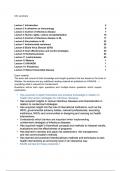CS: summary
Lecture 1 Introduction 2
Lecture 2 A refresher on immunology 6
Lecture 3 Control of infectious disease 7
Lecture 4 Human rights, culture and globalization 16
Lecture 5 Control of infectious disease in NL 17
Lecture 6 Vaccinations in NL 22
Lecture 7 Antimicrobial resistance 29
Lecture 8 Ebola Virus Disease (EVD) 35
Lecture 9 Cost effectiveness and control strategies 45
Lecture 10 Schistosomiasis 52
Lecture 11 Leishmaniasis 60
Lecture 12 Malaria 1
Lecture 13 HIV/AIDS 1
Lecture 14: Pandemics 1
Lecture 15 Blood transmitted disease 1
Exam material
The exam will consist of both knowledge and insight questions that are based on the book of
Webber, the lectures and any additional reading material as published on CANVAS. →
everything what is relevant for Containment!
Questions will be both open questions, and multiple choice questions which require
explanation.
,Lecture 1 Introduction
Containment strategies: interventions that limit/reduce/spread. ’war’ symbolics, strategies
to control, eliminate (local), eradicate (global) disease.
Infectious diseases: communicable, transmittable, contagious diseases (airborner, vector
borne, water/food borne, STD, zoonoses, etc.)
Global context: high/middle/low-income countries. from global to local (political, social,
economical, cultural diversity, regulations, international organizations)
How would you approach designing an intervention within context? → different frameworks:
1. preceed/proceed model: Green and Kreuter.
Planned behavior, everything that generates your
belief, can you control your behavior? understand
it! you know better what you can change if you
know this. Start with: what is happening? what
causes the behaviors to be there? after that you
can start your intervention plan.
2. Intervention mapping model: Bartholomew et al.
what do you want to change? stigma, condom
use, etc. if you know this, you know what you are
going to measure = change objectives.
3. Behavior change and communication models: theory of planned behavior, health
belief model, etc.
,5 steps in health intervention: Jenkins
Step 1: is it a priority health problem?
Burden of disease + portential burden
- Different measures (mortality/morbidiy, incidence/prevalence, DALY, global
burden of disease)
- Socio-economic impact
- For whom? (needs assessment)
Research methods:
- Routine information: registers, national data, hospital and clinic, disease
reports, lab tests
- Epidemiological data: cross-sectional study
- Community appraisals: questionnaires, interviews, focus groups, visualization
and diagramming
Total burden of disease: most low/middle income countries.
Step 2: What factors cause the problem?
What factors, settings etc → understand the problem.
Tools to identify causes:
- Epidemiological triangle → origin of the disease,
agent, environment and host + vector. web of
etiology. Multidisciplinary research /
transdisciplinary research.
- Problem tree/causal tree → Root cause analysis.
asking why?
Social determinants of healths = ecological model.
Factors influencing people.
, Step 3: How can these factors be changed?
5 strategies: use epi triangle as mind-map.
1. Remove the agent
2. Raise host resistance
3. Modify environment
4. Separate agent from host
5. Interrupt transmission → infected to non-infected individuals will be blocked.
Also:
- Prevention programs → deal with complex web of etiology (causation).
- Primary = before health effects occur, preventing infection, vaccination
- Secondary = screening in early stages, before onset symptoms,
mammography, blood pressure testing, early treatment
- Tertiary = already sick, preventing early death reduce the effects of
disease.
- Risk factor strategy → reducing risk + increasing protective factors.
Step 4: What overall intervention strategies are most appropriate and cost
effective?
What do people want + needs?
- Selecting the best intervention by doing analysis, using research methods
same as problem analysis.
- List relevant interventions + review them.
- Compare the intervention strategies with EIDM:
Evidence Informed Decision Making (EIDM): linking the problem to the solution.
- evidence matters → related to causes and the effectiveness of the solutions
- context matters → what contextual issues contribute to the problem? what solutions
works where for whom?
- integration of evidence, epistemological justice (TDR)






